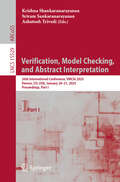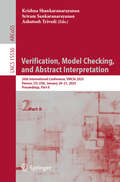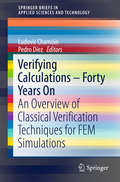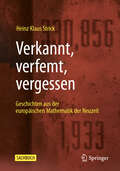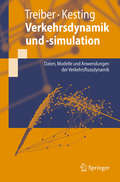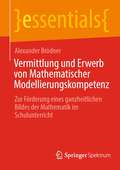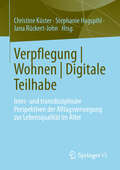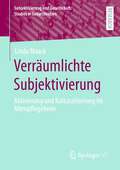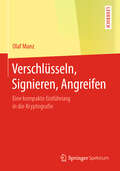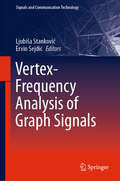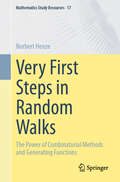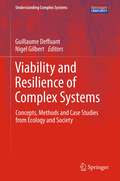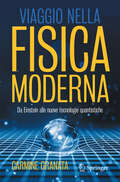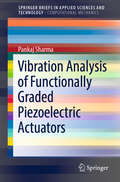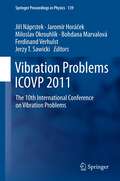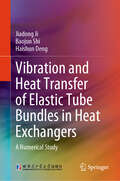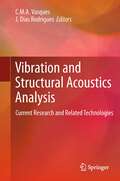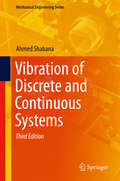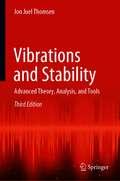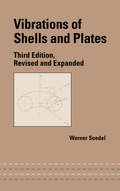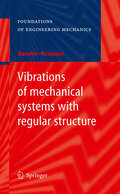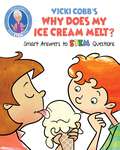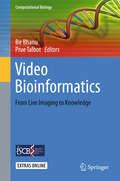- Table View
- List View
Verification, Model Checking, and Abstract Interpretation: 26th International Conference, VMCAI 2025, Denver, CO, USA, January 20–21, 2025, Proceedings, Part I (Lecture Notes in Computer Science #15529)
by Sriram Sankaranarayanan Krishna Shankaranarayanan Ashutosh TrivediThe two-volume set LNCS 15529 and 15530 constitutes the proceedings of the 26th International Conference on Verification, Model Checking, and Abstract Interpretation, VMCAI 2025, held in Denver, CO, USA, during January 20–21, 2025.The 20 full papers together with 2 accepted tool papers and 18 full length regular and case-study papers presented in the proceedings were carefully reviewed and selected from 48 submissions. The program of VMCAI 2025 conference in the core areas of VMCAI including abstract interpretation, programming languages, hardware and software model checking, cyber-physical systems, formal synthesis, formal methods in artificial intelligence, concurrency and other areas.
Verification, Model Checking, and Abstract Interpretation: 26th International Conference, VMCAI 2025, Denver, CO, USA, January 20–21, 2025, Proceedings, Part II (Lecture Notes in Computer Science #15530)
by Sriram Sankaranarayanan Krishna Shankaranarayanan Ashutosh TrivediThe two-volume set LNCS 15529 and 15530 constitutes the proceedings of the 26th International Conference on Verification, Model Checking, and Abstract Interpretation, VMCAI 2025, held in Denver, CO, USA, during January 20–21, 2025.The 20 full papers together with 2 accepted tool papers and 18 full length regular and case-study papers presented in the proceedings were carefully reviewed and selected from 48 submissions. The program of VMCAI 2025 conference in the core areas of VMCAI including abstract interpretation, programming languages, hardware and software model checking, cyber-physical systems, formal synthesis, formal methods in artificial intelligence, concurrency and other areas.
Verifying Calculations - Forty Years On
by Ludovic Chamoin Pedro DíezThis work provides an overview of a posteriori error assessment techniques for Finite Element (FE) based numerical models. These tools aim at estimating and controlling the discretization error in scientific computational models, being the basis for the numerical verification of the FE solutions. The text discusses the capabilities and limitations of classical methods to build error estimates which can be used to control the quality of numerical simulations and drive adaptive algorithms, with a focus on Computational Mechanics engineering applications. Fundamentals principles of residual methods, smoothing (recovery) methods, and constitutive relation error (duality based) methods are thus addressed along the manuscript. Attention is paid to recent advances and forthcoming research challenges on related topics. The book constitutes a useful guide for students, researchers, or engineers wishing to acquire insights into state-of-the-art techniques for numerical verification.
Verkannt, verfemt, vergessen: Geschichten aus der europäischen Mathematik der Neuzeit
by Heinz Klaus StrickSobald Sie sich eingehender mit der Geschichte der Mathematik beschäftigen, werden Sie auch auf Personen stoßen, deren Namen Ihnen bislang unbekannt waren oder von deren Bedeutung für die Entwicklung der Mathematik Sie bisher nichts wussten. Dieses Buch bietet Ihnen einen Einblick in das Leben und Wirken von 67 besonderen Persönlichkeiten aus dem europäischen Raum – und geht bei der Betrachtung der Einzelschicksale jeweils auch der Frage nach, warum diese Personen vergleichsweise unbekannt sind, warum sie regelrecht „vergessen“ wurden. Die Gründe dafür sind vielfältig und meist in den jeweiligen politischen, gesellschaftlichen oder individuellen Lebensumständen zu finden – viele wurden diskriminiert und konnten ihre Fähigkeiten gar nicht erst entfalten, andere waren Ihrer Zeit voraus und blieben lange Zeit unverstanden. Über die historische Einordnung hinaus werden einige der mathematischen Beiträge dieser Personen dargestellt – so ausgewählt, dass sie mit denin der gymnasialen Oberstufe üblicherweise vermittelten Kenntnissen nachvollzogen werden können. Die in diesem Buch enthaltenen Darstellungen beginnen mit Persönlichkeiten aus dem 16. Jahrhundert und schließen somit chronologisch an das Buch Geschichten aus der Mathematik desselben Autors an, sind aber unabhängig davon lesbar. Das Buch richtet sich an alle, die sich für die Entwicklung der Wissenschaften interessieren und dabei insbesondere ein tieferes Verständnis für die menschlichen Aspekte der Mathematik entwickeln möchten.
Verkehrsdynamik und -simulation
by Martin Treiber Arne KestingDas Lehrbuch liefert eine umfassende Darstellung der Modellierung und Dynamik des Straßenverkehrs. Es erschließt Studierenden ein Gebiet, das bisher nur in der englischsprachigen Originalliteratur dargestellt wurde. Aktuelle Anwendungen in Bereichen wie Verkehrsmanagement, Fahrer-Assistenzsysteme oder Verkehrstelematik stellen den Praxisbezug her, zahlreiche Abbildungen und Übungsaufgaben vertiefen das Verständnis. Das Buch richtet sich an Physik- und Verkehrsingenieurstudenten sowie Studierende der Informatik, Mathematik und technischer Richtungen.
Vermittlung und Erwerb von Mathematischer Modellierungskompetenz: Zur Förderung eines ganzheitlichen Bildes der Mathematik im Schulunterricht (essentials)
by Alexander BrödnerDieses Buch bietet eine grundlegende Einführung in die wichtigsten Aspekte der Vermittlung und des Erwerbs von mathematischer Modellierungskompetenz im Schulkontext. In den letzten Jahren hat sich unter anderem anhand der Covid-19 Pandemie mehr denn je gezeigt, wie Mathematik im Allgemeinen und das mathematische Modellieren im Speziellen zum Verständnis globaler Herausforderungen und Möglichkeiten zu ihrer Bewältigung beiträgt. Deshalb sollte die mathematische Modellierungskompetenz eine zentrale Rolle im Schulunterricht spielen. Dies kann auch zur Vermittlung eines ganzheitlichen Bildes der Mathematik beitragen. Doch der Prozess von Vermittlung und Erwerb einer solchen Kompetenz ist komplex und mit vielfältigen Schwierigkeiten verbunden. Angesichts dieser Ausgangslage fasst das Buch Geschichte und Definition der Modellierungskompetenz im Mathematikunterricht zusammen, stellt die damit verbundenen Ziele und Perspektiven dar, veranschaulicht theoretische Hintergrundüberlegungen, stellt Modellierungsaufgaben und passende Lernumgebungen vor und weist auf notwendige Teilkompetenzen und mögliche Hindernisse beim Erwerb von Modellierungskompetenz hin. Letztendlich wird damit auch der Anspruch der Vermittlung eines ganzheitlichen Bildes der Mathematik im Schulunterricht angesprochen. Als Zusammenfassung der wichtigsten Aspekte des mathematischen Modellierungskompetenz im Schulkontext richtet sich das Buch an Mathematikdidaktiker*innen und Lehrkräfte aller Schulformen.
Verpflegung | Wohnen | Digitale Teilhabe: Inter- und transdisziplinäre Perspektiven der Alltagsversorgung zur Lebensqualität im Alter
by Jana Rückert-John Christine Küster Stephanie HagspihlIn diesem Buch zum Thema Lebensqualität im Alter wird ein inter- und trans-disziplinärer Ansatz gewählt, um neue Einsichten zu vermitteln. Der spezielle Fokus in den Beiträgen liegt dabei auf den Themen Verpflegung, Wohnen und digitale Teilhabe, wobei die einzelnen Beiträge jeweils inter- und transdisziplinäre Perspektiven aufzeigen. Der steigende Anteil bzw. die steigende Zahl älterer Menschen und deren lebensnotwendige Alltagsversorgung und Alltagsgestaltung für mehr Lebensqualität betrifft die gesamte Gesellschaft. Die anstehenden Herausforderungen wachsender Disparitäten und wegbrechender Strukturen der Versorgung Älterer für ein „gutes Leben aller“ werden nur inter- und transdisziplinär zu lösen sein.
Verräumlichte Subjektivierung: Aktivierung und Kulturalisierung im Altenpflegeheim (Subjektivierung und Gesellschaft/Studies in Subjectivation)
by Linda MaackDas Buch zeigt aus einer rassismuskritischen Perspektive die Konstitution von (‚kultursensiblen‘) Altenpflegeheimen sowie darin eingelassene Subjekte und Adressierungen. Durch die Betrachtung von (‚kultursensiblen‘) Altenpflegeeinrichtungen werden diese Organisationen als zentrale Akteure der Subjektivierung thematisiert. In der diskursanalytischen Studie wird insbesondere der ‚Raum‘ als empirisches Konzept entwickelt, welcher das Subjekt durch Ein- und Ausschlüsse ‚kulturalisierend‘ hervorbringt. Damit leistet die Studie einen innovativen Beitrag zum Zusammenhang von Raum, Organisation und Subjektivierung.
Verschlüsseln, Signieren, Angreifen: Eine kompakte Einführung in die Kryptografie
by Olaf ManzDieses Buch erläutert kompakt, ohne theoretischen Überbau und mit möglichst wenig mathematischem Formalismus die wesentlichen Konzepte bei der Verschlüsselung schützenswerter Nachrichten und Daten. Hierbei liegt der Fokus auf der Beschreibung der historisch und für die Praxis wichtigen Chiffrier-, Signatur- und Authentifikationsverfahren. Dabei wird sowohl auf symmetrische Verschlüsselungen als auch auf Public-Key-Chiffren eingegangen. Angesprochen werden jeweils auch die Strategien, mit deren Hilfe man Verschlüsselungen angreift und zu „knacken“ versucht. Besonderer Wert gelegt wird auf die Darstellung des praktischen Einsatzes von Chiffren, insbesondere im alltäglichen Umfeld. Das Buch eignet sich für Arbeitsgruppen an MINT-Schulen und die MINT-Lehrerfortbildung, für Einführungskurse an Hochschulen wie auch für interessierte Schüler und Erwachsene.
Vertex-Frequency Analysis of Graph Signals (Signals and Communication Technology)
by Ervin Sejdić Ljubiša StankovićThis book introduces new methods to analyze vertex-varying graph signals. In many real-world scenarios, the data sensing domain is not a regular grid, but a more complex network that consists of sensing points (vertices) and edges (relating the sensing points). Furthermore, sensing geometry or signal properties define the relation among sensed signal points. Even for the data sensed in the well-defined time or space domain, the introduction of new relationships among the sensing points may produce new insights in the analysis and result in more advanced data processing techniques. The data domain, in these cases and discussed in this book, is defined by a graph. Graphs exploit the fundamental relations among the data points. Processing of signals whose sensing domains are defined by graphs resulted in graph data processing as an emerging field in signal processing.Although signal processing techniques for the analysis of time-varying signals are well established, the corresponding graph signal processing equivalent approaches are still in their infancy. This book presents novel approaches to analyze vertex-varying graph signals. The vertex-frequency analysis methods use the Laplacian or adjacency matrix to establish connections between vertex and spectral (frequency) domain in order to analyze local signal behavior where edge connections are used for graph signal localization. The book applies combined concepts from time-frequency and wavelet analyses of classical signal processing to the analysis of graph signals. Covering analytical tools for vertex-varying applications, this book is of interest to researchers and practitioners in engineering, science, neuroscience, genome processing, just to name a few. It is also a valuable resource for postgraduate students and researchers looking to expand their knowledge of the vertex-frequency analysis theory and its applications. The book consists of 15 chapters contributed by 41 leading researches in the field.
Vertrauen in die Polizei: Schweiz – Europa – Welt
by Sabrina PfisterDas vorliegende Buch befasst sich mit Vertrauen in die Polizei, wobei die Makroebene wie auch die Individualebene betrachtet und miteinander verknüpft werden. Auf der Makroebene fokussiert die Autorin die wahrgenommene Korruption, auf der Individualebene individuelle Werte sowie Migrationshintergründe als Erklärungsfaktoren. Insbesondere der Einfluss von Werten auf Vertrauen in die Polizei wurde bisher kaum untersucht. In dieser Analyse werden anhand einer Fallstudie über die Schweiz wie anhand welt- und europaweiter Ländervergleiche die Faktoren sowohl auf der Individual- als auch auf der Länderebene analysiert und folgende Forschungsfrage empirisch bearbeitet: Wie lassen sich Vertrauensunterschiede in die Polizei zwischen Menschen in einem Land und zwischen Ländern erklären? Es zeigt sich, dass öffentliche Korruption (gemessen mit dem Corruption Perceptions Index), die vier individuellen Werte «Bewahrung», «Macht», «Selbstbestimmung» und «Universalismus» nach der Wertetheorie von S. H. Schwartz (1992) und ein allenfalls vorhandener Migrationshintergrund Unterschiede im Vertrauen in die Polizei erklären können.
Very First Steps in Random Walks: The Power of Combinatorial Methods and Generating Functions (Mathematics Study Resources #17)
by Norbert HenzeWith this book, which is based on the third edition of a book first written in German about random walks, the author succeeds in a remarkably playful manner in captivating the reader with numerous surprising random phenomena and non-standard limit theorems related to simple random walks and related topics. The work stands out with its consistently problem-oriented, lively presentation, which is further enhanced by 100 illustrative images. The text includes 53 self-assessment questions, with answers provided at the end of each chapter. Additionally, 74 exercises with solutions assist in understanding the material deeply. The text frequently engages in concrete model-building, and the resulting findings are thoroughly discussed and interconnected. Students who have tested this work in introductory seminars on stochastics were particularly fascinated by the interplay of geometric arguments (reflection principle), combinatorics, elementary stochastics, and analysis. This book is a translation of an original German edition. The translation was done with the help of artificial intelligence. A subsequent human revision was done primarily in terms of content, so that the book will read stylistically differently from a conventional translation.
Viability and Resilience of Complex Systems
by Nigel Gilbert Guillaume DeffuantOne common characteristics of a complex system is its ability to withstand major disturbances and the capacity to rebuild itself. Understanding how such systems demonstrate resilience by absorbing or recovering from major external perturbations requires both quantitative foundations and a multidisciplinary view on the topic. This book demonstrates how new methods can be used to identify the actions favouring the recovery from perturbations. Examples discussed include bacterial biofilms resisting detachment, grassland savannahs recovering from fire, the dynamics of language competition and Internet social networking sites overcoming vandalism. The reader is taken through an introduction to the idea of resilience and viability and shown the mathematical basis of the techniques used to analyse systems. The idea of individual or agent-based modelling of complex systems is introduced and related to analytically tractable approximations of such models. A set of case studies illustrates the use of the techniques in real applications, and the final section describes how one can use new and elaborate software tools for carrying out the necessary calculations. The book is intended for a general scientific audience of readers from the natural and social sciences, yet requires some mathematics to gain a full understanding of the more theoretical chapters. It is an essential point of reference for those interested in the practical application of the concepts of resilience and viability
Viaggio nella fisica moderna: Da Einstein alle nuove tecnologie quantistiche
by Carmine GranataIl libro offre un breve viaggio nel sorprendente e spettacolare mondo della fisica moderna caratterizzato da idee e teorie dirompenti sia dal punto di vista concettuale che applicativo. Partendo dalla teoria della relatività di Einstein in cui i concetti di spazio, tempo e gravità vengono completamente rivisti, si arriva al bizzarro e affascinante universo della fisica quantistica che con le sue applicazioni ha cambiato completamente il nostro modo di vivere. Particolare attenzione è inoltre rivolta ai fondamenti concettuali e ai paradossi della meccanica quantistica grazie ai quali si è sviluppata in tempi più recenti la cosiddetta seconda rivoluzione quantistica, destinata a introdurre nelle nostre vite una nuova generazione di tecnologie quantistiche come computer, crittografia e teletrasporto. Oltre alle nuove tecnologie quantistiche, vengono illustrati in modo semplice e conciso i principi di funzionamento delle più importanti applicazioni della meccanica quantistica che si sono diffuse nella vita quotidiana. Il libro ha un carattere essenzialmente informativo, senza ricorrere a formule complicate o tecnicismi, pertanto non richiede conoscenze approfondite di fisica o matematica; le conoscenze acquisite nella scuola superiore sono sufficienti per comprendere gli argomenti trattati.
Vibration Analysis of Functionally Graded Piezoelectric Actuators (SpringerBriefs in Applied Sciences and Technology)
by Pankaj SharmaThis book presents a detailed study on the vibration analysis of functionally graded piezoelectric actuators excited under the shear effect. Two types of actuator geometries viz. beam and annular plate are considered, where the material properties are assumed to have a continuous variation in accordance with a power law distribution. The generalized differential quadrature method is used to obtain the solutions, and is compared to exact analytical results. The methodology reported and the numerical results presented will be useful for the design of devices utilizing functionally graded piezoelectric actuators under the influence of shear.
Vibration Problems ICOVP 2011
by Bohdana Marvalová Ferdinand Verhulst Jaromír Horáček Jerzy T. Sawicki Jiří Náprstek Miloslav OkrouhlíkThis volume presents the Proceedings of the 10th International Conference on Vibration Problems, 2011, Prague, Czech Republic. ICOVP 2011 brings together again scientists from different backgrounds who are actively working on vibration-related problems of engineering both in theoretical and applied fields, thus facilitating a lively exchange of ideas, methods and results between the many different research areas. The aim is that reciprocal intellectual fertilization will take place and ensure a broad interdisciplinary research field. The topics, indeed, cover a wide variety of vibration-related subjects, from wave problems in solid mechanics to vibration problems related to biomechanics. The first ICOVP conference was held in 1990 at A.C. College, Jalpaiguri, India, under the co-chairmanship of Professor M.M. Banerjee and Professor P. Biswas. Since then it has been held every 2 years at various venues across the World.
Vibration and Heat Transfer of Elastic Tube Bundles in Heat Exchangers: A Numerical Study
by Jiadong Ji Baojun Shi Haishun DengThis book systematically investigates the vibration and enhanced heat transfer of elastic tube bundles in heat exchangers. Using numerical calculation methods, it explores the working principles, optimization design, and performance enhancement of elastic tube bundle heat exchangers. The book presents research findings with clear illustrations and detailed analysis, allowing readers to gain a deep understanding and practical application of the subject. Whether from an academic research or engineering practice perspective, this book serves as a valuable reference and guide. It provides readers with insight and guidance on both theoretical and practical aspects of the field. With its comprehensive coverage and practical approach, this book is essential reading for researchers, engineers, and students interested in the vibration and heat transfer of elastic tube bundles in heat exchangers.
Vibration and Structural Acoustics Analysis
by J. Dias Rodrigues C.M.A. VasquesVibration and structural acoustics analysis has become an essential requirement for high-quality structural and mechanical design in order to assure acoustic comfort and the integrity, reliability and fail-safe behavior of structures and machines. The underlying technologies of this field of multidisciplinary research are evolving very fast and their dissemination is usually scattered over different and complementary scientific and technical publication means. In order to make it easy for developers and technology end-users to follow the latest developments and news in the field, this book collects into a single volume selected, extended, updated and revised versions of papers presented at the Symposium on Vibration and Structural Acoustics Analysis, coordinated by J. Dias Rodrigues and C. M. A. Vasques, which was organised as part of the 3rd International Conference on Integrity, Reliability & Failure (IRF'2009), co-chaired by J. F. Silva Gomes and Shaker A. Meguid, held at the Faculty of Engineering of the University of Porto, Portugal, 20-24 July 2009. These papers where chosen from the more than 60 papers presented at the conference symposium. Written by experienced practitioners and researchers in the field, this book brings together recent developments in the field, spanning across a broad range of themes: vibration analysis, analytical and computational structural acoustics and vibration, material systems and technologies for noise and vibration control, vibration-based structural health monitoring/evaluation, machinery noise/vibration and diagnostics, experimental testing in vibration and structural acoustics, applications and case studies in structural acoustics and vibration. Each chapter presents and describes the state of the art, presents current research results and discusses the need for future developments in a particular aspect of vibration and structural acoustics analysis. The book is envisaged to be an appealing text for newcomers to the subject and a useful research study tool for advanced students and faculty members. Practitioners and researchers may also find this book a one-stop reference that addresses current and future challenges in this field. The variety of case studies is expected to stimulate a holistic view of sound and vibration and related fields and to appeal to a broad spectrum of engineers such as the ones in the mechanical, aeronautical, aerospace, civil and electrical communities.
Vibration of Discrete and Continuous Systems (Mechanical Engineering Series)
by Ahmed ShabanaThis revised, updated textbook adds new focus on computational methods and the importance of vibration theory in computer-aided engineering to fundamental aspects of vibration of discrete and continuous systems covered in the previous two editions of Vibration of Discrete and Continuous Systems. Building on the book’s emphasis on the theory of vibration of mechanical, structural, and aerospace systems, the author’s modifications, including discussion of the sub-structuring and finite element formulations, complete the coverage of topics required for a contemporary, second course following Vibration Theory. The textbook is appropriate for both upper-level undergraduate and graduate courses.
Vibrations and Stability: Advanced Theory, Analysis, and Tools
by Jon Juel ThomsenAn ideal text for students that ties together classical and modern topics of advanced vibration analysis in an interesting and lucid manner. It provides students with a background in elementary vibrations with the tools necessary for understanding and analyzing more complex dynamical phenomena that can be encountered in engineering and scientific practice. It progresses steadily from linear vibration theory over various levels of nonlinearity to bifurcation analysis, global dynamics and chaotic vibrations. It trains the student to analyze simple models, recognize nonlinear phenomena and work with advanced tools such as perturbation analysis and bifurcation analysis. Explaining theory in terms of relevant examples from real systems, this book is user-friendly and meets the increasing interest in non-linear dynamics in mechanical/structural engineering and applied mathematics and physics. This edition includes a new chapter on the useful effects of fast vibrations and many new exercise problems.
Vibrations of Shells and Plates (Mechanical Engineering)
by Werner SoedelWith increasingly sophisticated structures involved in modern engineering, knowledge of the complex vibration behavior of plates, shells, curved membranes, rings, and other complex structures is essential for today‘s engineering students, since the behavior is fundamentally different than that of simple structures such as rods and beams. Now in its
Vibrations of mechanical systems with regular structure
by Mark Kempner Ludmilla BanakhVibrations in systems with a periodic structure is the subject of many ongoing research activities. This work presents the analysis of such systems with the help of the theory of representation groups by finite element methods, dynamic Compliance and dynamic rigidness methods, specially adjusted for the analysis of engineering structures. The approach presented in this book permits a simplification and facilitates the understanding of mechanical vibrations in various structures. The book includes extended studies of even complicated machinery structures with an emphasis on flight vehicle engines.
Vicki Cobb's Why Do I Dry Off?: STEM Kids Discover the Science of Evaporation (STEM Play)
by Vicki CobbHow do you dry off? Find out how in this new, colorful, easy-to-read STEM book! &“STEM&” is an acronym for Science, Technology, Engineering, and Math. Though these subjects are incredibly important to both education and society as a whole, they are often overlooked, especially after primary education is complete. A goal of this book is to introduce STEM to kids and make them excited about learning these central subjects. In Why Do I Dry Off?, your child will learn all about evaporation and the process of liquid changing into gas, an important part of the water cycle. Accomplished author and educator Vicki Cobb teaches your child all about this important aspect of STEM, while still making it fun and entertaining through bright illustrations, easy-to-understand language, and experiments broken down step-by-step. Your child will be so enthralled, they won&’t even realize they&’re learning! Introduce your child to vital STEM subjects and encourage them to learn about the world around them with Why Do I Dry Off?!
Vicki Cobb's Why Does My Ice Cream Melt?: Smart Answers to STEM Questions (STEM Play)
by Vicki CobbWhy does ice cream melt? Find out how in this new, colorful, easy-to-read STEM book! &“STEM&” is an acronym for Science, Technology, Engineering, and Math. Though these subjects are incredibly important to both education and society as a whole, they are often overlooked, especially after primary education is complete. A goal of this book is to introduce STEM to kids and make them excited about learning these central subjects. In Why Does My Ice Cream Melt?, your child will learn all about the states of water, including the water cycle. Accomplished author and educator Vicki Cobb teaches your child all about this important aspect of STEM, while still making it fun and entertaining through bright illustrations, easy-to-understand language, and experiments broken down step-by-step. Your child will be so enthralled, they won&’t even realize they&’re learning! Introduce your child to vital STEM subjects and encourage them to learn about the world around them with Why Does My Ice Cream Melt?!
Video Bioinformatics
by Bir Bhanu Prue TalbotThe advances of live cell video imaging and high-throughput technologies for functional and chemical genomics provide unprecedented opportunities to understand how biological processes work in subcellular and multicellular systems. The interdisciplinary research field of Video Bioinformatics is defined by Bir Bhanu as the automated processing, analysis, understanding, data mining, visualization, query-based retrieval/storage of biological spatiotemporal events/data and knowledge extracted from dynamic images and microscopic videos. Video bioinformatics attempts to provide a deeper understanding of continuous and dynamic life processes. Genome sequences alone lack spatial and temporal information, and video imaging of specific molecules and their spatiotemporal interactions, using a range of imaging methods, are essential to understand how genomes create cells, how cells constitute organisms, and how errant cells cause disease. The book examines interdisciplinary research issues and challenges with examples that deal with organismal dynamics, intercellular and tissue dynamics, intracellular dynamics, protein movement, cell signaling and software and databases for video bioinformatics. Topics and Features * Covers a set of biological problems, their significance, live-imaging experiments, theory and computational methods, quantifiable experimental results and discussion of results. * Provides automated methods for analyzing mild traumatic brain injury over time, identifying injury dynamics after neonatal hypoxia-ischemia and visualizing cortical tissue changes during seizure activity as examples of organismal dynamics * Describes techniques for quantifying the dynamics of human embryonic stem cells with examples of cell detection/segmentation, spreading and other dynamic behaviors which are important for characterizing stem cell health * Examines and quantifies dynamic processes in plant and fungal systems such as cell trafficking, growth of pollen tubes in model systems such as Neurospora Crassa and Arabidopsis * Discusses the dynamics of intracellular molecules for DNA repair and the regulation of cofilin transport using video analysis * Discusses software, system and database aspects of video bioinformatics by providing examples of 5D cell tracking by FARSIGHT open source toolkit, a survey on available databases and software, biological processes for non-verbal communications and identification and retrieval of moth images This unique text will be of great interest to researchers and graduate students of Electrical Engineering, Computer Science, Bioengineering, Cell Biology, Toxicology, Genetics, Genomics, Bioinformatics, Computer Vision and Pattern Recognition, Medical Image Analysis, and Cell Molecular and Developmental Biology. The large number of example applications will also appeal to application scientists and engineers. Dr. Bir Bhanu is Distinguished Professor of Electrical & C omputer Engineering, Interim Chair of the Department of Bioengineering, Cooperative Professor of Computer Science & Engineering, and Mechanical Engineering and the Director of the Center for Research in Intelligent Systems, at the University of California, Riverside, California, USA. Dr. Prue Talbot is Professor of Cell Biology & Neuroscience and Director of the Stem Cell Center and Core at the University of California Riverside, California, USA.
